Types of Lawn Weeds (with Their Picture and Name) – Identification and Control
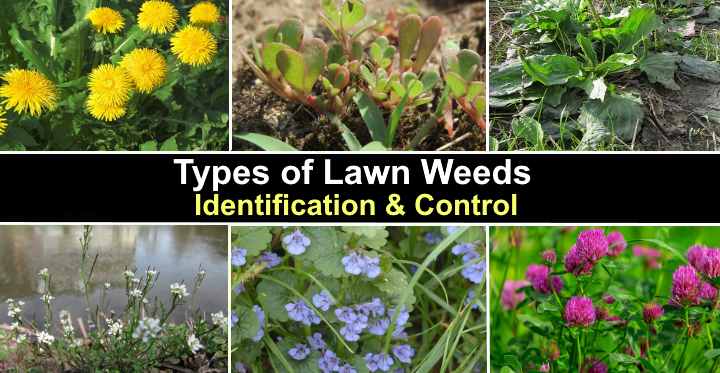
Lawn weeds are pesky unwelcome plants that can destroy your lawn’s beautiful appearance. But getting a weed-free lawn can be challenging. Not all lawn weeds look alike. And some types of grassy weeds like crabgrass and nutsedge look like grass and are hard to identify. Other invasive broadleaf weeds in lawns can have purple or yellow flowers. Because stubborn weeds like creeping Charlie, dandelions, and oxalis have creeping roots, the unwanted plants can be hard to get rid of in a healthy lawn.
Getting rid of lawn weeds effectively requires a multi-method approach. Of course, the easiest way to remove weeds from a lush, green lawn is by digging them up. However, in many cases, you need to eliminate the weed roots in the turfgrass to prevent your lawn from appearing uneven and patchy again. Additionally, it’s vital to maintain healthy grass by aerating lawns, fertilizing them, and removing thatch.
This article is a guide to identifying the common weeds that can ruin the appearance of your entire lawn. Additionally, you’ll learn about various control methods to get rid of stubborn weeds in your lawn for good.
What Are Lawn Weeds?
Lawn weeds are invasive broadleaf plants or grassy plants that grow in lawns. The weedy plants spoil the appearance of a lush lawn and affect grass growth. Some plants like dandelions are perennial weeds that come back year after year. Annual weeds like crabgrass die off each season and regrow from seed.
How to Identify Lawn Weeds?
To get rid of weeds in your lawn, proper identification is vital. Some broadleaf weeds like creeping Charlie and dandelions are easy to spot because of their characteristic flowers. To identify lawn weeds, look at the leaves. Are they straight blades like regular grass? Or are the leaves broad with serrated edges?
It’s crucial to identify the different types of lawn weed to get rid of them for good. Perennial, creeping weeds tend to have invasive, spreading roots. This means that just digging up the plant isn’t enough to eliminate the weed. All parts of the root need removing from turfgrass. However, annual lawn weeds can be eradicated by pulling them up by hand.
What are the Most Common Lawn Weeds?
Lawn weeds are common throughout the world. There are over 30 types of lawn weeds, and they grow in USDA zones 2 through 12. So, if you care for a lawn in your front or backyard, the chances are that you must deal with types of weeds sooner or later.
Here are some of the most common weeds you are likely to see growing in your lawn:
- Creeping Charlie—This irritating lawn weed is an invasive creeping plant with scalloped leaves and clusters of purple flowers blooming in spring.
- Dandelions—A common yellow-flowering weed with narrow, lance-shaped irregularly lobed leaves.
- Crabgrass—A pesky annual weed that looks like clumps of grass and can make lawns look unkempt and bumpy.
- Oxalis—This broadleaf perennial weed often grows in lawns where you don’t want it. The weedy plant has clover-like leaves and yellow buttercup flowers.
- Quackgrass—A persistent noxious weed with fast-growing, creeping growth that can quickly destroy your lawn’s appearance.
What Are Weeds With Purple Flowers Called?
Some lawn weeds with purple flowers are creeping Charlie, purple speedwell, doves-foot cranesbill, henbit, wild violet, red clover, and purple deadnettle. Purple-flowering lawn weeds can be annuals or perennials.
Plants with purple flowers have their place in the garden—but not growing in the middle of your well-kept lawn.
What Are Weeds with Yellow Flowers Called?
Common lawn weeds with yellow flowers are dandelion, oxalis, purslane, and yellow sweet clover.
Weedy plants with yellow flowers may add bright colors to your lawn. But rather than ruining the appearance of healthy turfgrass, it’s best for plants with yellow flowers to grow in flower beds, not a lawn.
How to Get Weeds Out of Grass
The easiest way to remove weeds from grass is to remove them physically. First, use a small trowel or garden fork to dig up all the weeds and roots from the lawn. Then, fill the patch with compost and lawn seed to prevent lawns from becoming patchy after digging up weeds.
Related reading: Types of lawn grass.
In their battle against weeds, some gardeners use a chemical all-in-one weed killer to eliminate weeds. However, it’s usually best to use natural methods for weed removal to prevent having potentially harmful chemicals in your garden.
An issue with getting rid of lawn weeds naturally is that some household products may not be effective. For example, white vinegar, dish soap, or boiling water may be fine for weeds on the sidewalk, but they can kill both weeds and grass roots.
Patchy lawns can also be a sign of grubs in the grass.
Types of Lawn Weeds (with Names and Pictures): Identification Guide
Let’s look in detail at how to identify the common types of lawn weeds. You will also find out how to control this unwanted plant in your turf for each type of weed.
Creeping Charlie (Glechoma hederacea) – Creeping Lawn Weed
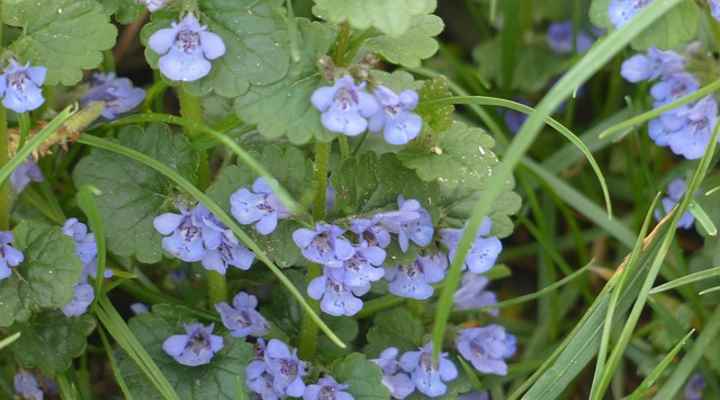
Creeping Charlie (Glechoma hederacea) is a creeping lawn weed
Creeping Charlie is a common lawn weed that spreads across lawns and can be difficult to remove altogether. Also called ground ivy, this aggressive creeping lawn weed has shallow roots and pulls out easily from the ground.
Lawn Weed Identification: Creeping Charlie is identified by its scalloped leaves with serrated margins, delicate lilac flowers, and creeping stems that root almost anywhere.
Lawn Weed Control Tips: Pull out the invasive creeping lawn weed stems by hand to remove the plant from lawns. You can also pour a borax solution to destroy this weed without harming your lawn. Dissolve 5 tsp. of borax in a quart (1 l) of water and apply evenly to 25 sq. ft. (2.3 sq. m.) of lawn.
Quackgrass (Elytrigia repens)
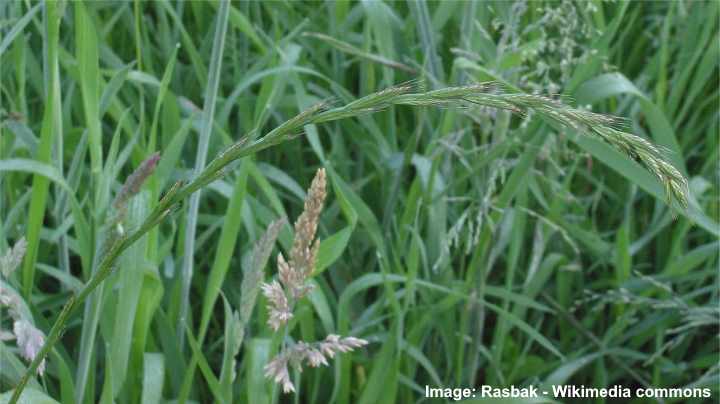
Quackgrass (Elytrigia repens)
Quackgrass has easily identifiable long, wide-leafed grass blades with a rough feel. Quackgrass forms a dense mat of weedy grasses in lawns and quickly grows back after removing the blades. The roots also form tight clumps in turfgrass, making them challenging to remove.
Lawn Weed Identification: To identify quackgrass weeds in lawns, look for the wheat-like stalks growing in among tufts of grass-like blades.
Lawn Weed Control Tips: To control quackgrass, dig up the noxious creeping weed, making sure to remove the roots. You can also pour hot water into the hole to kill off the remaining roots.
Canada Thistle (Cirsium Arvense) – Creeping Lawn Weed
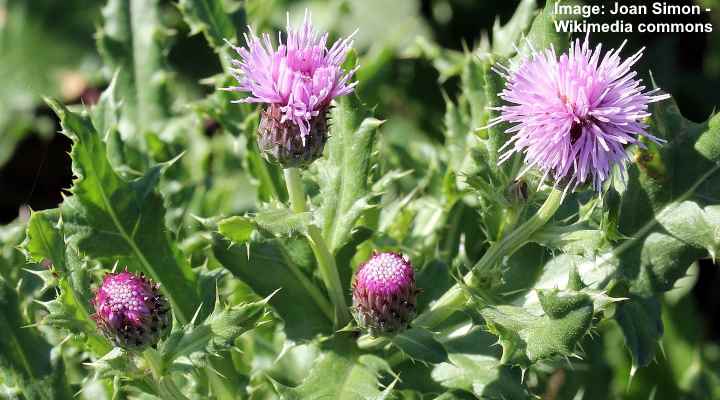
Canada Thistle (Cirsium Arvense)
Canada thistle is a persistent creeping purple lawn weed with thick jaggy leaves that grow in clumps. Canada thistle is a perennial weed, challenging to remove from lawns due to its deep roots. The pesky weed spreads through buds in its root system, extending 3 ft. (1 m) wide and deep.
Lawn Weed Identification: Canada thistle has identifiable spiky green leaves that grow in a rosette pattern, appearing in mid to late spring. Its characteristic purple flowers bloom in summer. The creeping perennial weeds grow 8” to 12” (20 – 30 cm) apart.
Lawn Weed Control Tips: Difficult to control because of the large, spreading roots. Most gardeners recommend a postemergence herbicide or chemical weed killers to get rid of Canada thistle completely.
Clover (Trifolium) – Creeping Lawn Weed

Clover (Trifolium). Red clover (Trifolium pratense) on top left and white clover (Trifolium repens) on top right
Some gardeners view clover as an irritating weed in lush lawns. In contrast, other gardeners like a healthy percentage of clover growing among grass. Clover spreads by creeping stems that produce long roots that send up new shoots.
Lawn Weed Identification: Clover is a creeping lawn weed that has recognizable three or four small oval leaves. Depending on the species, clover can grow purple flowers (red clover (Trifolium pratense) or white flowers (Trifolium repens).
Lawn Weed Control Tips: The best way to completely remove clover naturally is by hand pulling it after heavy rainfall or thorough lawn watering. Alternatively, you could check out this article on why clover can be beneficial for your lawn.
Dandelion (Taraxacum officinale) – Common Lawn Weed

Dandelion (Taraxacum officinale)
Dandelion is a common lawn weed with recognizable yellow flowers and long, lanceolate leaves with lobed margins. A dandelion is a nuisance in lawns and hard to remove due to its deep taproot and light seeds that disperse quickly. In addition, a clump of dandelions can ruin the appearance of a beautiful lawn.
Lawn Weed Identification: The familiar identification features of dandelion are clumps of lance-shaped leaves with irregular lobing and bright yellow flowers that look like the sun. After flowering, dandelions have a recognizable puffball that disperses seeds to the rest of the lawn and surrounding areas.
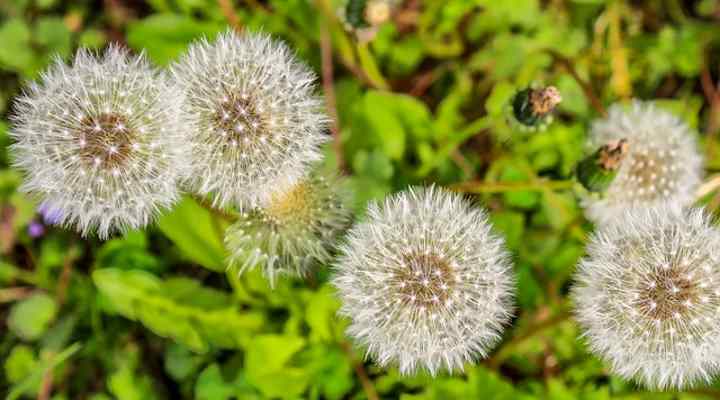
Dandelion seed heads
Lawn Weed Control Tips: Use a dandelion digger to remove as much of the taproot weed as possible. Leaving grass clippings on the lawn acts as mulch to prevent dandelion seeds from germinating.
Crabgrass (Digitaria)

Crabgrass (Digitaria)
Crabgrass is an annual invasive plant that quickly takes over lawns that are under-nourished. Clumps of this ground-hugging plant appear in summer. It disperses thousands of seeds in late summer, ready to sprout the following spring.
Lawn Weed Identification: Crabgrass weeds are easy to spot in spring because the tufts of foliage are lighter than regular turf grass. During the growing season, the clumps of weedy grass become thicker and start growing in a star shape. Purple stems appear before it starts seeding.
Lawn Weed Control Tips: The best control method for crabgrass weeds is to maintain a healthy lawn. Remove thatch in spring and regularly overseed your lawn to create a healthy root system.
Plantain (Plantago)
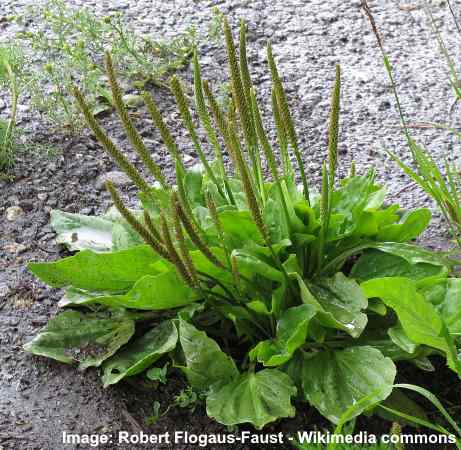
Broadleaf plantain (Plantago major)
Plantain is a broadleaf perennial weed that commonly invades lawns with compacted soil or poorly established grass roots. Plantain weeds have broad oval leaves or narrow pointed leaves, depending on the species. Seeds grow on the end of long stems that create an unsightly appearance in lawns.
Lawn Weed Identification: Plantain weeds are easy to identify due to their rounded leaves growing in a rosette form. Upright stems bear greenish-white cone-shaped flower clusters from May until September.
Lawn Weed Control Tips: The best way to control plantain weeds is to dig up the relatively shallow roots. Also, maintaining a healthy lawn, regular mowing, and keeping the blade at 3” (7.5 cm) high will help prevent plantain from becoming a nuisance.
Dallisgrass (Paspalum dilatatum)
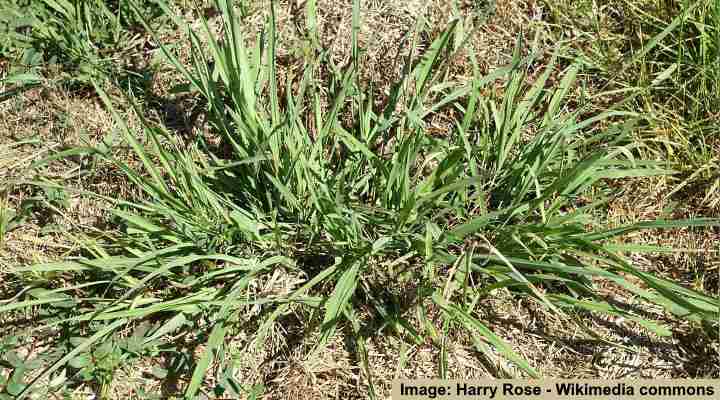
Dallisgrass (Paspalum dilatatum)
Dallisgrass is a fast-growing lawn weed that makes lawns look bumpy and unsightly due to tufts of wide blades growing. Dallisgrass becomes a nuisance in lawns by spreading through short rhizome roots. In time, the tufts of weedy grass can become a large circular flat clump that chokes out lawn grass.
Lawn Weed Identification: The grass-like blades grow up to 10” long and form compact clumps in turfgrass.
Lawn Weed Control Tips: Proper mowing and maintaining a healthy lawn is the best way to control dallisgrass in your lawn if you live in warmer climates. Correct watering and fertilization will also inhibit weed growth. Dig up any existing dallisgrass clumps and reseed the bare patches of the lawn.
Nutsedge (Cyperus)
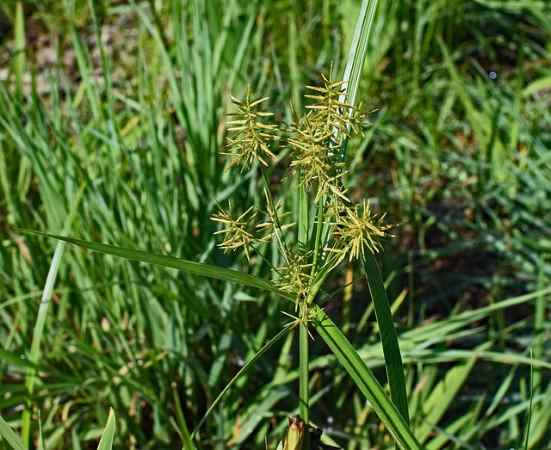
Nutsedge (Cyperus)
Nutsedge is a fast-growing persistent weed that looks like grass. The weedy plant spreads through tubers and can quickly form patches of unsightly grass in lawns with poor drainage. Eradication of nutsedge from lawns is best done as soon as the weed appears and before tubers become established.
Lawn Weed Identification: Nutsedge lawn weed is easy to identify by its yellowish-green shiny leaves and three-sided, triangular stems growing in sets of three. The invasive lawn weed appears as lighter patches of thick grass that are significantly longer than regular grass.
Lawn Weed Control Tips: To control nutsedge weeds, water the ground thoroughly and gently pull the long grass-like clumps out by hand.
Common Ragweed (Ambrosia artemisiifolia)
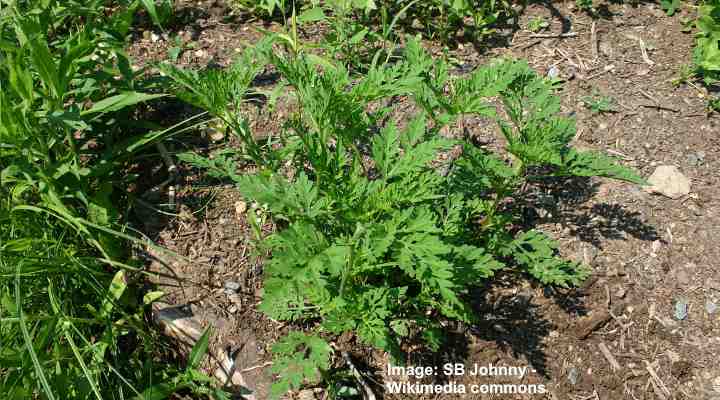
Common Ragweed (Ambrosia artemisiifolia)
Common ragweed is a native annual lawn weed with thin, fern-like leaves. Ragweed has shallow roots, and it thrives in poor, compacted soil. Ragweed is so invasive because the plant can disperse over 60,000 seeds a season. Even if you think you completely got rid of this lawn weed, it has the habit of appearing the following year.
Lawn Weed Identification: Common ragweed has distinctive leaves with fern-like, feathery green foliage. The leaves grow in small clusters on lawns.
Lawn Weed Control Tips: The best way to control common ragweed in lawns is to mow your lawn regularly to prevent weed seed dispersal. Additionally, aerating your lawn and keeping it well-nourished will prevent soil compaction and nutrient deficiencies.
Purslane (Portulaca oleracea)

Purslane (Portulaca oleracea)
Purslane is a low-growing invasive lawn weed that spreads rapidly by dispersing seeds. Purslane thrives in warm, humid conditions on fertilized lawns and weakened grass. The invasive properties of purslanes occur if the stems are left to grow in lawns or on the soil surface. In a single season, a mature plant can produce over 50,000 seeds.
Lawn Weed Identification: Purslane weeds have easily recognizable obovate-shaped succulent leaves that grow on sprawling red stems. Purslane also produces five-petalled yellow flowers.
Lawn Weed Control Tips: It is easy to control purslane by removing it by hand. However, it’s best to hand pull the weedy plant in spring before it has a chance to produce seeds. Also, you must remove the entire root.
Hairy Bittercress Weed (Cardamine hirsuta)
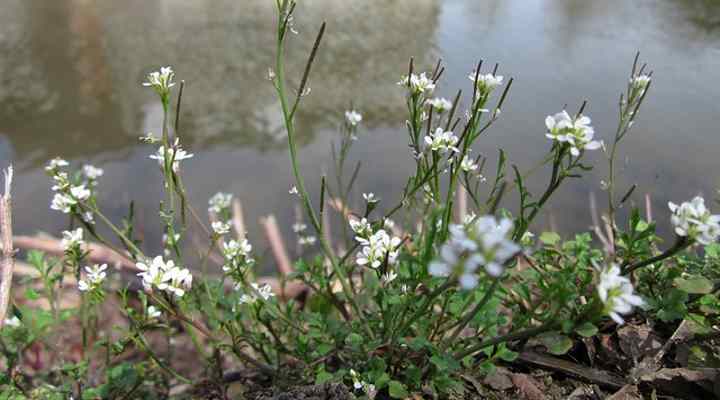
Hairy Bittercress Weed (Cardamine hirsuta)
Hairy bittercress is a white flowering weed that commonly appears on lawns early in the season. The broadleaf weed appears as a flat clump of stems with small oval leaves, producing white flowers in spring. Hairy bittercress spreads rapidly through seeds that it produces after flowering in spring.
Lawn Weed Identification: Hairy bittercress is identified as a low-growing rosette clump of pinnate leaves growing on outstretching stems.
Lawn Weed Control Tips: Hairy bittercress weed control is best done by regular mowing early in the season. This weed control method prevents erect stems from growing and inhibits seed production.
Dollarweed (Hydrocotyle)
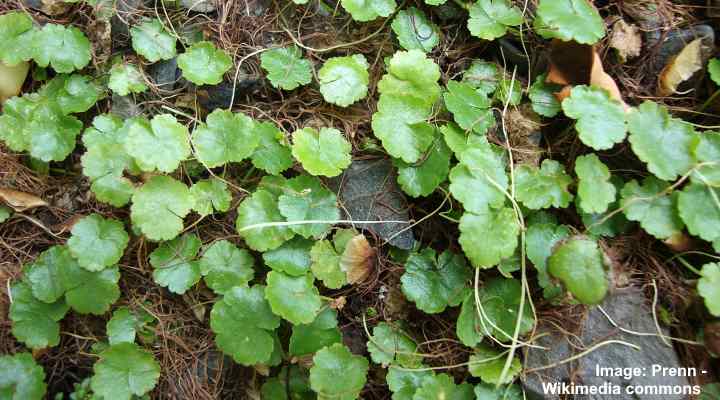
Dollarweed (Hydrocotyle)
Dollarweed is a warm-season, broadleaved creeping lawn weed that thrives in damp lawns with poor drainage and few nutrients. Also called pennywort, this perennial weedy lawn plant with rounded, scalloped-edged leaves and white summer-blooming flowers is common in shaded lawns. Dollarweed is so invasive because it spreads through creeping underground rhizomes and seeds.
Lawn Weed Identification: Dollarweed is easy to identify due to its distinctive round leaves in the shape of a dollar. Also, look for the scalloped, wavy margins of the round leaves growing on prostrate spreading steams. The leafy weed leaves look like small lily pads.
Lawn Weed Control Tips: To prevent weed growth, reduce watering to allow the soil to dry out partially. Then mow the lawn regularly, keeping the grass length at 3” (7.5 cm) tall. Additionally, aerating the lawn to prevent compaction can help to improve turfgrass health.
Grass Stickers (Lawn Burweed)

Burweed (Soliva sessilis)
Grass stickers are annual weeds that produce seed pods covered in sharp burs. Also called sandburs, in cooler climates, stickers die back in the winter and return from seed in spring. However, in warmer regions, the jagged grassy weed grows as perennial and overwinters in lawns and flowerbeds.
Burweed grows rapidly in lawns and tends to invade worn, stressed, or bare patches of turfgrass. The noxious weed can grow 2” (5 cm) tall and up to 6” (15 cm) wide. Thanks to its numerous seeds contained in spiky pods, grass stickers can quickly take over a lawn.
Lawn Weed Identification: Grass stickers can be identified by their spiky seed pods and thousands of little sticky weeds. If not treated, grass stickers can create dense infestations of painful lawn burs.
Lawn Weed Control Tips: Hand-pulling grass stickers and raking the spreading spiky weeds are the best ways to get rid of grass stickers. The fastest way to eliminate grass stickers is to burn them with a propane hand torch. However, you can also try applying vinegar or baking soda as a natural control method.
How to Prevent Lawn Weeds
The best way to prevent lawn weed issues is to practice excellent lawn care methods. This means mowing high, fertilizing lawns regularly, removing thatch, aerating lawns, and overseeding them. Healthy turfgrass with a robust root system prevents weeds from taking root. Additionally, keeping grass longer prevents sunlight from allowing weed seeds to germinate and sprout.
Learn how to identify the most common flowering weeds.
Related articles:
- Homemade Weed Killers: Natural, Safe, Non-Toxic DIY Weed Killers
- Organic Lawn Care: How to Maintain Your Lawn Naturally
- How to Get Rid of Grubs in the Lawn
